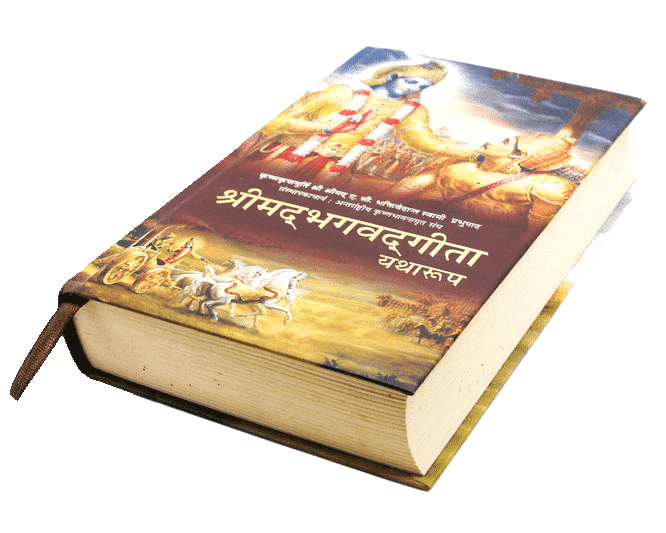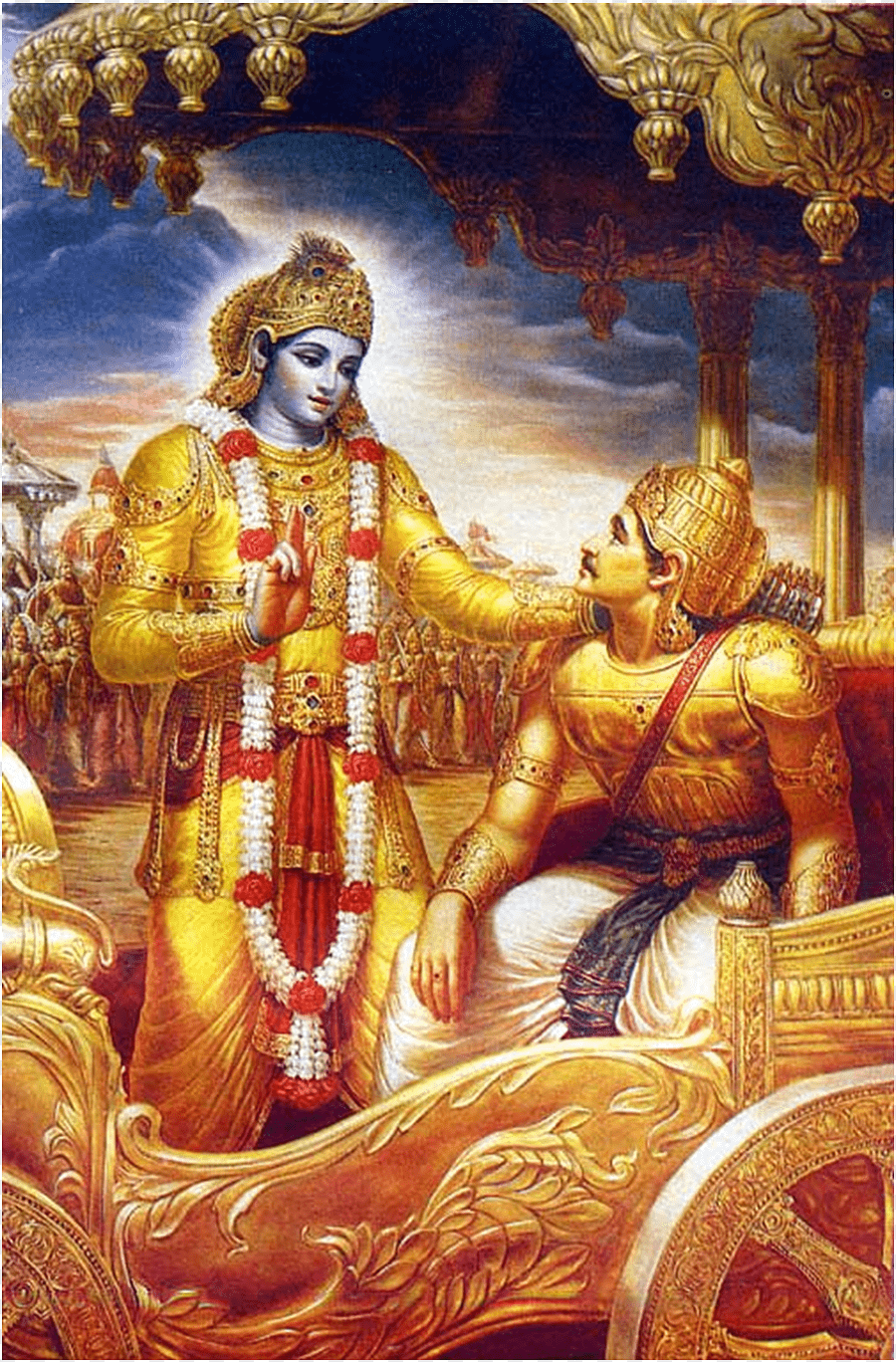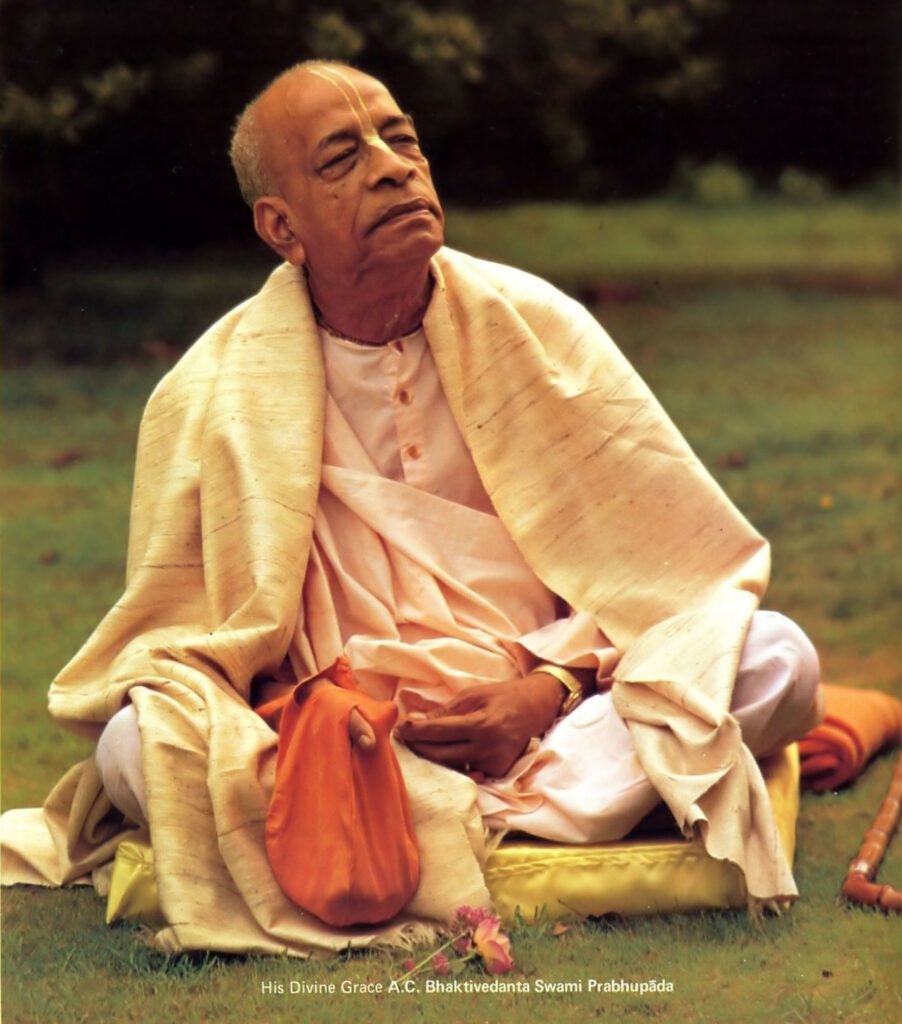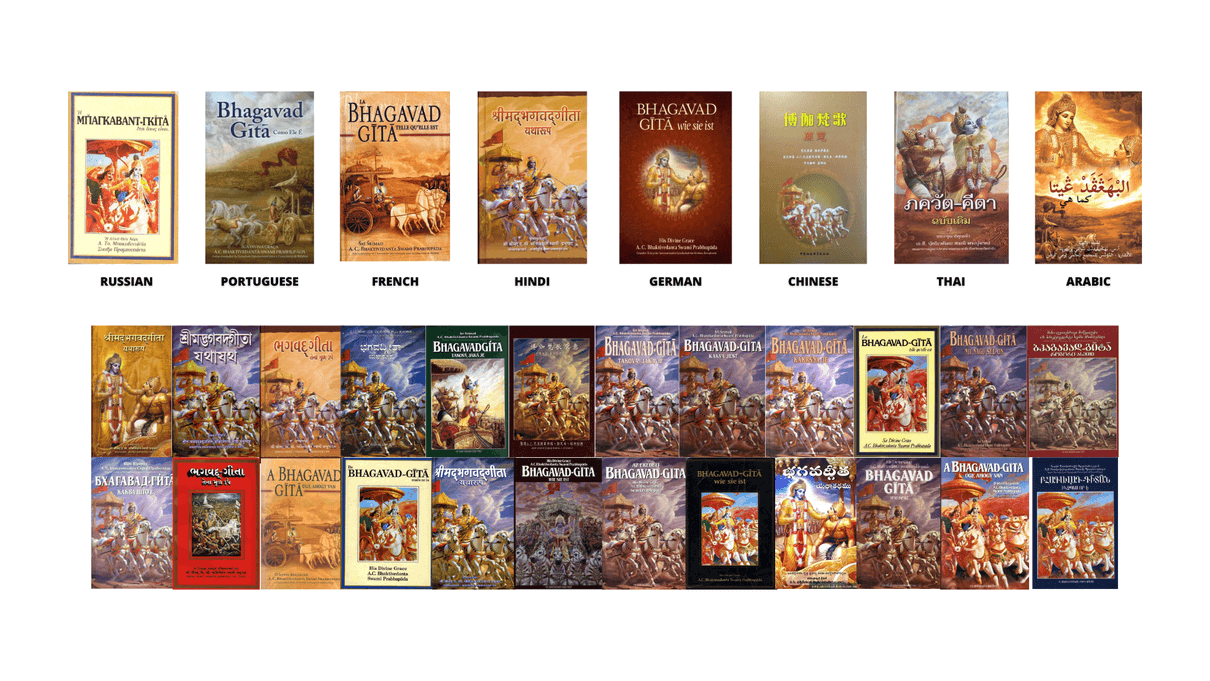
Bhagavad-gita 2.40
Overview
Poised for the biggest battle of his life with the hopes of millions of people resting on him to lead them to victory in a war for justice, the great hero Arjuna suddenly reels and begins to falter and tremble. The real magnitude of the situation and ghastly consequences of impending war hit him with full force. To fight for justice, Arjuna will have to likely kill all these men, many if not most of whom are his friends, teachers, and kin who were and still are very near and dear to him. Arjuna is completely confused, overwhelmed, in denial and paralysed. To escape the situation, he ponders giving it all up to go live his life as a recluse in a forest.It is at this moment that Krishna – The Cosmic Consciousness, the Supersoul, the Supreme Personality of Godhead, who had so far been acting as Arjuna’s friend and charioteer reveals His true identity. He leads Arjuna through a discussion of the karma, jnana and bhakti yogas, revealing the nature of divinity, humankind’s ultimate destiny, and the purpose of mortal life.

Who should read this book?
Does your mind seem like a battlefield struggling to make decisions?
Looking for ways to overcome self-doubt and anxiety?
Can’t quite figure out your purpose in life and how and why everything exists?

Want to go deeper in the perfection of Yoga?
Wish to live a more authentic and truly fulfilling life in tune with your real self?
Wonder about death, what it means and how to boldly face the inevitable?
You'll get
1
An extraordinarily deep and inspiring account of the Universe, of the Self, and of the Divine and the relationship amongst the three which ultimately explains life, death, meaning and purpose.
2
A precise and clear philosophical perspective which removes self-doubt, anxiety and confusion so you can make better decisions with confidence and go from paralysis and procrastination to action!
3
A systematic exposition on the various types and gradations of Yoga, how they are to be performed, how one progressively leads to the next and their ultimate aim of illumination, self-realisation and liberation.
What’s inside?
We’ve selected three passages to give you a sample right now. Pick one and get a feel for the book, explore its philosophy, presentation and message to see if it resonates with you.
Bhagavad-gītā is also known as Gītopaniṣad. It is the essence of Vedic knowledge and one of the most important Upaniṣads in Vedic literature. Of course there are many commentaries in English on the Bhagavad-gītā, and one may question the necessity for another one. This present edition can be explained in the following way. Recently an American lady asked me to recommend an English translation of Bhagavad-gītā. Of course in America there are so many editions of Bhagavad-gītā available in English, but as far as I have seen, not only in America but also in India, none of them can be strictly said to be authoritative because in almost every one of them the commentator has expressed his own opinions without touching the spirit of Bhagavad-gītā as it is.
The spirit of Bhagavad-gītā is mentioned in Bhagavad-gītā itself. It is just like this: If we want to take a particular medicine, then we have to follow the directions written on the label. We cannot take the medicine according to our own whim or the direction of a friend. It must be taken according to the directions on the label or the directions given by a physician. Similarly, Bhagavad-gītā should be taken or accepted as it is directed by the speaker Himself. The speaker of Bhagavad-gītā is Lord Śrī Kṛṣṇa. He is mentioned on every page of Bhagavad-gītā as the Supreme Personality of Godhead, Bhagavān. Of course the word bhagavān sometimes refers to any powerful person or any powerful demigod, and certainly here bhagavān designates Lord Śrī Kṛṣṇa as a great personality, but at the same time we should know that Lord Śrī Kṛṣṇa is the Supreme Personality of Godhead, as is confirmed by all great ācāryas (spiritual masters) like Śaṅkarācārya, Rāmānujācārya, Madhvācārya, Nimbārka Svāmī, Śrī Caitanya Mahāprabhu and many other authorities of Vedic knowledge in India. The Lord Himself also establishes Himself as the Supreme Personality of Godhead in the Bhagavad-gītā, and He is accepted as such in the Brahma-saṁhitā and all the Purāṇas, especially the Śrīmad-Bhāgavatam, known as the Bhāgavata Purāṇa (kṛṣṇas tu bhagavān svayam). Therefore we should take Bhagavad-gītā as it is directed by the Personality of Godhead Himself.
TEXT 15
O best among men [Arjuna], the person who is not disturbed by happiness and distress and is steady in both is certainly eligible for liberation.
PURPORT
Anyone who is steady in his determination for the advanced stage of spiritual realization and can equally tolerate the onslaughts of distress and happiness is certainly a person eligible for liberation. In the varṇāśrama institution, the fourth stage of life, namely the renounced order (sannyāsa) is a painstaking situation. But one who is serious about making his life perfect surely adopts the sannyāsa order of life in spite of all difficulties. The difficulties usually arise from having to sever family relationships, to give up the connection of wife and children. But if anyone is able to tolerate such difficulties, surely his path to spiritual realization is complete. Similarly, in Arjuna’s discharge of duties as a kṣatriya, he is advised to persevere, even if it is difficult to fight with his family members or similarly beloved persons. Lord Caitanya took sannyāsa at the age of twenty-four, and His dependants, young wife as well as old mother, had no one else to look after them. Yet for a higher cause He took sannyāsa and was steady in the discharge of higher duties. That is the way of achieving liberation from material bondage.
TEXT 16
Those who are seers of the truth have concluded that of the nonexistent there is no endurance, and of the existent there is no cessation. This seers have concluded by studying the nature of both.
PURPORT
There is no endurance of the changing body. That the body is changing every moment by the actions and reactions of the different cells is admitted by modern medical science; and thus growth and old age are taking place in the body. But the spirit soul exists permanently, remaining the same despite all changes of the body and the mind. That is the difference between matter and spirit. By nature, the body is ever changing, and the soul is eternal. This conclusion is established by all classes of seers of the truth, both impersonalist and personalist. In the Viṣṇu Purāṇa it is stated that Viṣṇu and His abodes all have self-illuminated spiritual existence. “Jyotīṁṣi viṣṇur bhavanāni viṣṇuḥ.“ The words existent and nonexistent refer only to spirit and matter. That is the version of all seers of truth.
This is the beginning of the instruction by the Lord to the living entities who are bewildered by the influence of ignorance. Removal of ignorance involves the reestablishment of the eternal relationship between the worshiper and the worshipable and the consequent understanding of the difference between the part and parcel living entities and the Supreme Personality of Godhead. One can understand the nature of the Supreme by thorough study of oneself, the difference between oneself and the Supreme being understood as the relationship between the part and the whole. In the Vedānta-sūtras, as well as in the Śrīmad-Bhāgavatam, the Supreme has been accepted as the origin of all emanations. Such emanations are experienced by superior and inferior natural sequences. The living entities belong to the superior nature, as it will be revealed in the Seventh Chapter. Although there is no difference between the energy and the energetic, the energetic is accepted as the Supreme, and energy or nature is accepted as the subordinate. The living entities, therefore, are always subordinate to the Supreme Lord, as in the case of the master and the servant, or the teacher and the taught. Such clear knowledge is impossible to understand under the spell of ignorance, and to drive away such ignorance the Lord teaches the Bhagavad-gītā for the enlightenment of all living entities for all time.
TEXT 3
The total material substance, called Brahman, is the source of birth, and it is that Brahman that I impregnate, making possible the births of all living beings, O son of Bharata.
PURPORT
This is an explanation of the world: everything that takes place is due to the combination of kṣetra and kṣetrajna, the body and the spirit soul. This combination of material nature and the living entity is made possible by the Supreme God Himself. The mahat–tattva is the total cause of the total cosmic manifestation, and because in the total substance of the material cause there are three modes of nature, it is sometimes called Brahman. The Supreme Personality impregnates that total substance, and thus innumerable universes become possible. This total material substance, the mahat–tattva, is described as Brahman in the Vedic literature: tasmād etad brahma nāma–rūpam annaṁ ca jāyate. Into that Brahman the seeds of the living entities are impregnated by the Supreme Person. The twenty-four elements, beginning from earth, water, fire and air, are all material energy, called Mahā–brahman, or the great Brahman, the material nature. As is explained in the Seventh Chapter, beyond this there is another, superior nature-the living entity. In material nature the superior nature is mixed by the will of the Supreme Personality of Godhead, and thereafter all living entities are born of this material nature.
The scorpion lays its eggs in piles of rice, and sometimes it is said that the scorpion is born out of rice. But the rice is not the cause of the scorpion. Actually, the eggs were laid by the mother. Similarly, material nature is not the cause of the birth of the living entities. The seed is given by the Supreme Personality of Godhead, and they only seem to come out as products of material nature. Thus every living entity, according to his past activities, has a different body, created by this material nature, and the entity can enjoy or suffer according to his past deeds. The Lord is the cause of all the manifestations of living entities in this material world.
Purchase your copy now and get FREE access to our BG course valued at $49
This course is designed as a study guide to help you get the most out of your reading. It contains short video commentaries, chapter summaries, key points, prompts, and quizzes to help you navigate the book, retain, and apply the philosophy in your daily life.
Purchase
What you will learn
- Familiarizing oneself with the characters, plot, and themes of the Bhagavad Gita.
- Exploring the concept of dharma and its role in our lives.
- Gaining insight into the importance of meditation and mindfulness.
- Exploring the concept of karma and its role in shaping one's life.
- Examining the relevance of the Bhagavad Gita in daily life and how it can help you live to your highest potential.
- Learning about the various schools of Vedic philosophy and how they relate to the Bhagavad- gita.
- Understanding the nature of the self (atma) and the ultimate reality (Brahman).
- Learning about the different yogas (spiritual paths) described in the Bhagavad Gita, such as Karma Yoga, Jnana Yoga and Bhakti Yoga.
- Understanding the relationship between action and detachment in the Bhagavad Gita.
- Learning about the teachings of the Bhagavad Gita related to social justice, duty, and morality.
Meet Srila Prabhupada
Srila Prabhupada is the founder acharya (spiritual head) of the International Society for Krishna Consciousness (ISKCON). Srila Prabhupada not only brought bhakti yoga and the Hare Krishna maha-mantra to the western world but also circled the globe 14 times on lecture tours, bringing the teachings of Krishna and the Bhagavad-gita to thousands of people on six continents.
Men and women from all backgrounds and walks of life came forward to accept this message, and with their help, Srila Prabhupada established ISKCON centers and projects throughout the world. His edition of ‘Bhagavad-gita – As it Is’ is the highest-selling version of the Gita globally, having sold more than 30 million copies in 55 different languages to date.

30+ Million Copies sold in 55 languages worldwide

One who is thus transcendentally situated at once realizes the Supreme Brahman and becomes fully joyful. He never laments or desires to have anything. He is equally disposed toward every living entity. (18.54)
The Supreme is situated in everyone’s heart, O Arjuna, and is directing the wanderings of all living entities, who are seated as on a machine, made of the material energy. (18.61)
As a person puts on new garments, giving up old ones, similarly, the soul accepts new material bodies, giving up the old and useless ones. (2.22)
In this endeavor there is no loss or diminution, and a little advancement on this path can protect one from the most dangerous type of fear. (2.40)
The Vedas mainly deal with the subject of the three modes of material nature. Rise above these modes, O Arjuna. Be transcendental to all of them. Be free from all dualities and from all anxieties for gain and safety, and be established in the Self. (2.45)
What is night for all beings is the time of awakening for the self-controlled; and the time of awakening for all beings is night for the introspective sage. (2.69)
The bewildered spirit soul, under the influence of the three modes of material nature, thinks himself to be the doer of activities, which are in actuality carried out by nature. (3.27)
Whatever state of being one remembers when he quits his body, O son of Kuntī, that state he will attain without fail. (8.6)
Now I am confused about my duty and have lost all composure because of weakness. In this condition I am asking You to tell me clearly what is best for me. (2.7)
O son of Kuntī, the nonpermanent appearance of happiness and distress, and their disappearance in due course, are like the appearance and disappearance of winter and summer seasons. They arise from sense perception, O scion of Bharata, and one must learn to tolerate them without being disturbed. (2.14)
Humility; pridelessness; nonviolence; tolerance; simplicity; approaching a bona fide spiritual master; cleanliness; steadiness; self-control; renunciation of the objects of sense gratification; absence of false ego; the perception of the evil of birth, death, old age and disease; detachment; freedom from entanglement; even-mindedness amid pleasant and unpleasant events; constant and unalloyed devotion to Me; aspiring to live in a solitary place; detachment from the general mass of people; accepting the importance of self-realization; and philosophical search for the Absolute Truth – all these I declare to be knowledge, and besides this whatever there may be is ignorance. (13.8-12)
He who is temperate in his habits of eating, sleeping, working and recreation can mitigate all material pains by practicing the yoga system. (6.17)
From anger, delusion arises, and from delusion bewilderment of memory. When memory is bewildered, intelligence is lost, and when intelligence is lost, one falls down again into the material pool. (2.63)
Whatever action is performed by a great man, common men follow in his footsteps. And whatever standards he sets by exemplary acts, all the world pursues. (3.21)

